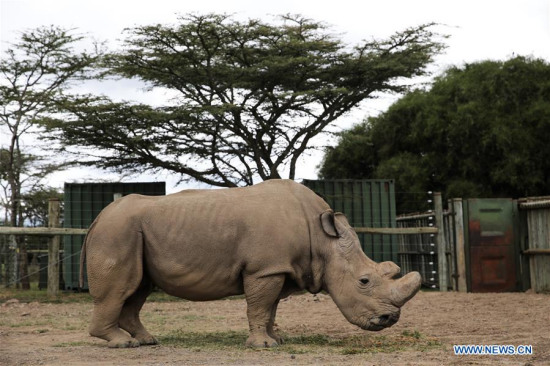
Photo taken on April 28, 2016 shows Sudan, the last male northern white rhino in the world, at Ol Pejeta Conservancy in Nanyuki, Kenya. (Xinhua/Pan Siwei)
The world's only remaining male northern white rhino has been battling with a life-threatening ailment, throwing the world's conservationists into a spin.
The 45-year-old giant land mammal, fondly named as Sudan, has been sheltered at the Ol Pejeta Conservancy in the northern Kenyan county of Laikipia, and has lately grappled with an infection on his right hind leg, undermining his capacity to roam around and forage.
Sudan's health remained critical though veterinarians have been attending to him twice a day, Elodie Sampere, communications manager at Ol Pejeta Conservancy told Xinhua in an interview.
"There has been no significant improvement on the health of Sudan and doctors are on the standby to administer treatment twice a day," Sampere said, adding that conservationists and scientists are still hopeful the iconic species will overcome the current ailment.
Conservationists from all over the world have been fascinated by the last remaining male northern white rhino with concerted efforts to prolong its lifespan.
Under a "Last Chance to Survive" breeding program supported by global wildlife campaigners, Sudan and two of his female partners were relocated to their current abode in northern Kenya in 2009 to induce their breeding through a conducive natural habitat.
However, due to advanced age, Sudan was unable to breed with his female partners, Fatu and Najin, adding to the fear that the white rhino subspecies was on the verge of extinction.
GLOBAL CAMPAIGN
Ol Pejeta Conservancy last year kicked off a global campaign to save the world's last remaining subspecies of white rhinos through In Vitro Fertilization (IVF).
Among the modern reproductive technologies, scientists are considering using southern white rhinos as surrogates to carry the northern white rhino's embryos, which would cost as much as 1 million U.S. dollars.
The campaign hit a crescendo last year when a dating app, Tinder, named Sudan the most eligible bachelor in the world. Since then, well-wishers have made considerable donations to support the surrogate birth.
In January, two globally renowned monumental sculpture artists, Gillie and Marc Schattner, announced that they were carving three giant rhino sculptures that would be unveiled in New York City to raise awareness on the plight of the only three remaining northern white rhinos on the planet.
"The sculptures will be used to raise awareness and gather 1 million goodbye messages from the world. Gillie and Marc will then take these messages and use them as petition to stop the trading," Ol Pejeta Conservancy said in a statement.
It revealed that the two artists will recreate Sudan, Najin and Fatu into life-sized bronze sculptures so that everyone in the world would get a chance to see them, touch them, hug them and say goodbye to the iconic species.
Ol Pejeta Conservancy disclosed that each rhino bronze sculpture would be stacked on top of the other to illustrate how fragile but magnificent these creatures were, arousing the sentiment to halt their extinction.
TIP OF ICEBERG
Ol Pejeta Conservancy, East Africa's largest black rhino sanctuary, has been updating well-wishers on the health status of Sudan, and a recent Facebook post from the conservancy struck a positive note indicating that Sudan's health improved slightly following a heavy down pour.
"It has been raining heavily on Ol Pejeta for the past couple of days and the weather certainly seems to have lifted Sudan's spirits. He has been able to wallow in the mud with the careful assistance of his caregivers, something that he seems to savor," Ol Pejeta Conservancy posted on its Facebook account Tuesday.
"We are cautiously optimistic that he (Sudan) will respond favorably to the treatments that are being administered by our vet teams," said the conservancy. His two female counterparts have remained in good health.
According to Kenya Wildlife Service (KWS), the global population of northern white rhino subspecies stood at about 2,000 in the 1960s but it shrank to the current three due to poaching and habitat loss.
The fate of northern white rhinos is just the tip of the iceberg. According to the 2016 Living Planet Report by the World Wildlife Fund, the global population of fish, birds. mammals, amphibians and reptiles declined by 58 percent between 1970 and 2012.
The organization also said the experts calculated that 0.01-0.1 percent of all species will extinct each year, at an unprecedented speed between 1,000 and 10,000 times higher than the natural extinction rate.
ONGOING BATTLE
Kenya has earned global acclaim for its spearheading efforts to save the world's three last remaining northern white rhinos, and wildlife entities like Ol Pejeta Conservancy that occupies an estimated 90,000 acres of land have been at the fore front in the battle.
Heavily armed guards have been providing 24-hour security for Sudan to protect it from poachers who are to blame for the reduction in the population of the rhino subspecies in Kenya.
The Kenyan government has also stepped up efforts to save rhinos through a raft of measures such as punitive legal action on poachers as well as community participation in the conservation of the iconic species.
Najib Balala, cabinet secretary for tourism and wildlife, told Xinhua that Kenya was undeterred in its commitment to saving all rhino subspecies despite jitters caused by Sudan's illness.
"This northern white rhino, the only remaining in the world, came from Czechoslovakia. It was brought to Kenya to survive. But unfortunately, we cannot control age. It is now 45 years old. But we have very elaborate programs for southern white and black rhinos," said Balala.
He further noted that the population of rhinos and elephants has gone up due to investments in robust anti-poaching measures. Balala also thanked China for rallying behind such efforts.
Kenya currently hosts a population of around 1,100 rhinos, the third largest globally after South Africa and Namibia.


















































